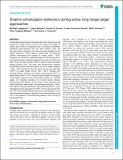Dolphin echolocation behaviour during active long-range target approaches
Abstract
Echolocating toothed whales generally adjust click intensity and rate according to target range to ensure that echoes from targets of interest arrive before a subsequent click is produced, presumably facilitating range estimation from the delay between clicks and returning echoes. However, this click-echo-click paradigm for the dolphin biosonar is mostly based on experiments with stationary animals echolocating fixed targets at ranges below ∼120 m. Therefore, we trained two bottlenose dolphins instrumented with a sound recording tag to approach a target from ranges up to 400 m and either touch the target (subject TRO) or detect a target orientation change (subject SAY). We show that free-swimming dolphins dynamically increase interclick interval (ICI) out to target ranges of ∼100 m. TRO consistently kept ICIs above the two-way travel time (TWTT) for target ranges shorter than ∼100 m, whereas SAY switched between clicking at ICIs above and below the TWTT for target ranges down to ∼25 m. Source levels changed on average by 17log10(target range), but with considerable variation for individual slopes (4.1 standard deviations for by-trial random effects), demonstrating that dolphins do not adopt a fixed automatic gain control matched to target range. At target ranges exceeding ∼100 m, both dolphins frequently switched to click packet production in which interpacket intervals exceeded the TWTT, but ICIs were shorter than the TWTT. We conclude that the click-echo-click paradigm is not a fixed echolocation strategy in dolphins, and we demonstrate the first use of click packets for free-swimming dolphins when solving an echolocation task.
Citation
Ladegaard , M , Mulsow , J , Houser , D S , Jensen , F H , Johnson , M , Madsen , P T & Finneran , J J 2019 , ' Dolphin echolocation behaviour during active long-range target approaches ' , Journal of Experimental Biology , vol. 222 , jeb189217 . https://doi.org/10.1242/jeb.189217
Publication
Journal of Experimental Biology
Status
Peer reviewed
ISSN
0022-0949Type
Journal article
Description
Financial support was provided by the US Office of Naval Research Code 32 (Mine Countermeasures, Acoustics Phenomenology & Modeling Group). M.L. and P.T.M. were funded by frame grants from the National Danish Research Council (Det Frie Forskningsråd) and by a Semper Ardens grant from the Carlsberg Foundation. M.L.’s travel expenses were covered by grants from Augustinus Fonden and DAS-Fonden (Danish Acoustical Society, Dansk Akustisk Selskab). F.H.J. was funded by an AIAS-COFUND fellowship from Aarhus Institute of Advanced Studies under the EU's Seventh Framework Programme (Agreement No. 609033).Collections
Items in the St Andrews Research Repository are protected by copyright, with all rights reserved, unless otherwise indicated.

